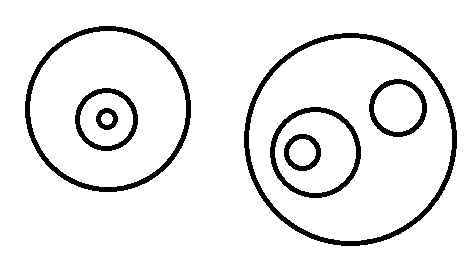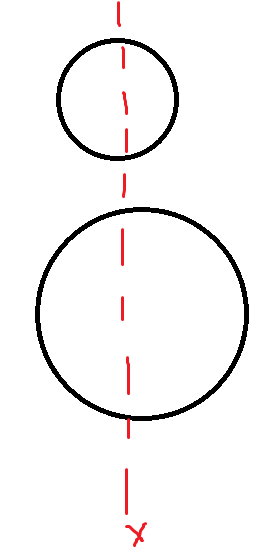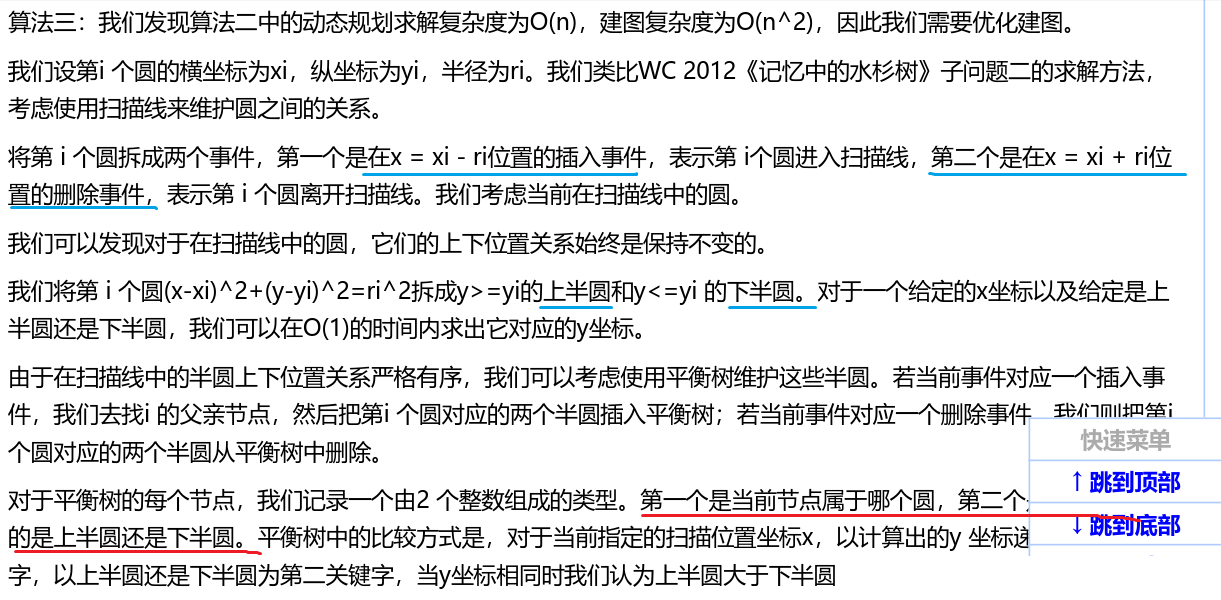

说白了,就是这个样子:

这个玩意明显是一个优美的树形结构
是个森林
然后建个虚点0,并且w[0]=0,然后树形dp即可
f[x]=max(w[x],∑f[son])
难点是:树怎么建?
就要上计算几何了:
如果我们用扫描线扫过去
发现,同时存在的两个圆,由于不相交,不相切,所以 相对位置始终保持不变
或者说,不论扫到哪个位置,两个圆的四个纵坐标的相对大小是固定的。

基于这个优秀的事实,
判断圆的相互包含关系,这样处理:


画个图就明白了
这个都是基于:“纵坐标相对大小不变”的事实,所以,不管扫描线怎么动,虽然纵坐标变了,但是不用重新建平衡树,因为形态还是不变的
这使得插入的时候,这个树还是正确的,直接找前驱就是对的了
用set就可以
重载小于号,用全局变量P来比较(只有插入和查询前驱的时候会进行比较)
(比较的第二关键字还是有用的,因为同时插入两个半圆壳,纵坐标那个时候是相同的)
由于会出现r=0的情况,所以扫描线的处理,横坐标相同,插入在前,删除在后。
代码:
#include<bits/stdc++.h> #define reg register int #define il inline #define numb (ch^'0') using namespace std; typedef long long ll; il void rd(ll &x){ char ch;x=0;bool fl=false; while(!isdigit(ch=getchar()))(ch=='-')&&(fl=true); for(x=numb;isdigit(ch=getchar());x=x*10+numb); (fl==true)&&(x=-x); } namespace Miracle{ const int N=100000+5; int n; ll P;//PPPPPPPPPPPPPPPPPPPPPPPPPPPPPPPPPPPPPPPPPPPPPPPPPPPPPPPPPPPPPPPPPPPPPPPPPPPPPPPPPP struct circle{ ll x,y,r; int w; long double calc(ll p,int fl){ return (long double)y+fl*sqrt((long double)r*r-(long double)(p-x)*(p-x)); } }c[N]; struct po{ int id,fl;//fl=1 up; fl=-1 down po(){} po(int x,int y){ id=x;fl=y; } bool friend operator <(po a,po b){ if(c[a.id].calc(P,a.fl)!=c[b.id].calc(P,b.fl)) return c[a.id].calc(P,a.fl)<c[b.id].calc(P,b.fl); return a.fl<b.fl; } }; set<po>s; set<po>::iterator it; struct que{ int pos,id,typ; bool friend operator <(que a,que b){ if(a.pos!=b.pos)return a.pos<b.pos; return a.typ>=b.typ; } }q[2*N]; int tot; struct node{ int nxt,to; }e[2*N]; int hd[N],cnt; int du[N]; int fa[N]; void add(int x,int y){ e[++cnt].nxt=hd[x]; e[cnt].to=y; hd[x]=cnt; } int f[N]; bool vis[N]; void dfs(int x){ vis[x]=1; for(reg i=hd[x];i;i=e[i].nxt){ int y=e[i].to; if(!vis[y]){ dfs(y); f[x]+=f[y]; } } f[x]=max(f[x],c[x].w); } int main(){ scanf("%d",&n); for(reg i=1;i<=n;++i){ rd(c[i].x);rd(c[i].y);rd(c[i].r);//rd(c[i].w); scanf("%d",&c[i].w); q[++tot].pos=c[i].x-c[i].r; q[tot].id=i;q[tot].typ=1; q[++tot].pos=c[i].x+c[i].r; q[tot].id=i;q[tot].typ=-1; } sort(q+1,q+tot+1); for(reg i=1;i<=tot;++i){ P=q[i].pos; // cout<<q[i].pos<<" "<<q[i].id<<" "<<q[i].typ<<endl; // cout<<c[1].calc(P,1)<<" and "<<c[1].calc(P,-1)<<" "<<c[q[i].id].calc(P,1)<<endl; if(q[i].typ==1){ it=s.upper_bound(po(q[i].id,1)); if(it!=s.end()){ if((*it).fl==1){ // cout<<" find up "<<endl; fa[q[i].id]=(*it).id; add((*it).id,q[i].id); }else{ fa[q[i].id]=fa[(*it).id]; add(fa[(*it).id],q[i].id); } }else{ fa[q[i].id]=0; add(0,q[i].id); } s.insert(po(q[i].id,1)); s.insert(po(q[i].id,-1)); }else{ s.erase(po(q[i].id,1)); s.erase(po(q[i].id,-1)); } } dfs(0); printf("%d ",f[0]); return 0; } } signed main(){ freopen("2.in","r",stdin); freopen("2.out","w",stdout); Miracle::main(); return 0; } /* Author: *Miracle* Date: 2019/2/10 8:46:45 */